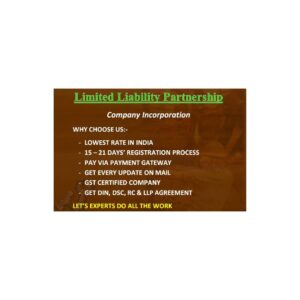 How LLP works┬Ā ┬Ā ┬Ā ┬Ā ┬Ā ┬Ā ┬Ā
How LLP works┬Ā ┬Ā ┬Ā ┬Ā ┬Ā ┬Ā ┬Ā
┬Ā ┬Ā ┬Ā ┬Ā ┬Ā ┬Ā ┬Ā ┬Ā ┬Ā ┬Ā ┬Ā ┬Ā ┬Ā ┬Ā ┬Ā ┬Ā ┬Ā ┬Ā ┬Ā ┬Ā ┬Ā ┬Ā ┬Ā ┬Ā ┬Ā ┬Ā ┬Ā ┬Ā ┬Ā ┬Ā ┬Ā ┬Ā ┬Ā ┬Ā ┬Ā ┬Ā ┬Ā ┬Ā ┬Ā ┬Ā ┬Ā ┬Ā┬Ā

An Limited Liability Partnership is a unique business structure that blends elements of partnerships and corporations to provide certain benefits to its owners. Here’s an overview of how an LLP typically works:
1. Formation:
An LLP incorporate with two or more partners who enter into a partnership agreement. The partnership agreement outlines the rights, responsibilities, and obligations of the partners, as well as the governance and decision-making processes of the LLP.
┬Ā2.Limited Liability:
One of the key advantages of an LLP is that partners have limited liability. This means that partners are generally not personally responsible for the debts and liabilities of the LLP. However, partners may personally liable for their own wrongful acts or misconduct.
3.Partners:
LLP partners contribute capital, skills, or resources to the LLP. They may have different roles and responsibilities based on their agreement. Partners share in both profits and losses of the LLP according to the partnership agreement, typically based on their capital contributions or as specified in the agreement.
┬Ā4.Management:
The LLP can manage through all partners collectively, or certain partners may designate as managing partners responsible for day-to-day operations. The partnership agreement determines the decision-making processes, voting rights, and management structure of the LLP.
┬Ā5.Taxation:
LLPs┬Ā generally tax as pass-through entities, meaning that the LLP itself does not pay taxes on its profits. Instead, profits and losses flow through to the partners, who report them on their individual tax returns.
┬Ā6.Liability and Indemnity:
Partners in an LLP are typically not personally liable for the acts, debts, or liabilities of other partners. Each partner’s liability is limited to the extent of their capital contributions or as specified in the partnership agreement. However, partners may be jointly and severally liable for certain obligations, such as tax liabilities or breaches of the partnership agreement.
┬Ā7.Flexibility and Adaptability:
LLPs offer flexibility in terms of their internal structure, decision-making processes, profit sharing arrangements, and management. The partnership agreement allows partners to tailor the LLP’s operations to suit their both specific needs and objectives.
8.Regulatory Compliance:
LLPs are subject to various regulatory requirements and compliance obligations, including filing annual returns, maintaining proper accounting records, and adhering to tax regulations. LLPs must comply with the laws and regulations of the jurisdiction where they are registered.
For more information visit this site: https://www.mca.gov.in
It’s important to note that the specific rules and regulations governing LLPs can vary by jurisdiction. Therefore, it’s advisable to consult the laws and regulations applicable to LLPs in your specific jurisdiction and seek professional advice when establishing and operating an LLP.
For further details access our website: https://vibrantfinserv.com